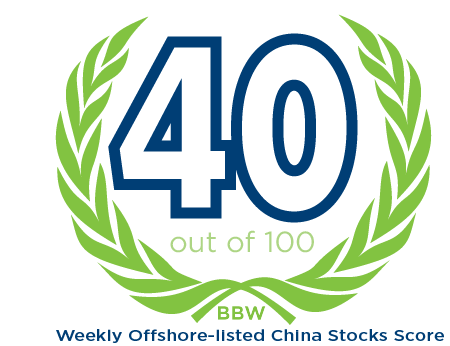CHINA BULLETIN: Local Governments Crushed by Debt


In this week’s issue China’s crushing debt, green energy overtakes coal and Evergrande ordered to liquidate. On a scale of 1 to 100, we give the week a 40 for offshore-listed China stocks.
Doug Young, Editor in Chief
You can sign up to get China Bulletin weekly in your inbox.
MACRO
Provinces Get Set for Slower Growth
In an acknowledgement that China’s economy is slowing, many provinces are lowering their growth targets for 2024. Of the 27 provinces, regions and municipalities that had given out forecasts as of last Friday, only five set their economic growth targets higher this year than for 2023. Many have become more conservative since missing recent goals.
This widespread lowering of expectations looks quite significant, as it may indicate someone at the top is telling the provinces “It’s ok not to grow so quickly all the time.” In the past, provinces were always under huge pressure to set and meet big growth targets each year, doing their part to help Beijing reach its often-ambitious GDP growth goals for the entire country.
Local Governments Crushed by Debt
New full-year data is showing just how heavy China’s debt burden is becoming, falling especially hard on local governments. One data point shows the country’s debt-to-GDP ratio rose to a record 288% last year, 13.5 percentage points higher than in 2022. Another shows local governments paid a record $174 billion in interest on their bonds for the year, which excludes off-book borrowing.
Both figures show not only how China is trying to spend its way out of its economic slowdown using more debt, but also how that debt is slowly crushing local governments as their traditional funding from land sales dries up. This kind of growing debt would be unsustainable in the West, though Japan has shown it can continue for quite a long time in certain Asian countries.
Factory Indicators Paint Mixed Picture for January
Widely watched manufacturing indicators painted a mixed picture in January, with one showing growth and the other contraction. On the growth side, the Caixin PMI for the month came in at 50.8, unchanged from December. But the official PMI stood at 49.2, improving from December but still below the 50 threshold that’s the dividing line between expansion and contraction.
The dichotomy seems to show the private sector is faring better in the current economic slowdown than China’s massive state-run sector, since the Caixin PMI is concentrated among companies from the former while the official PMI focuses on the latter. Exports were a key bright spot in the reports, so it’s quite possible that private sector companies benefited from their strength in that area.
China Stocks Return to Losing Ways
After a brief “dead cat rally” last week on eternal hopes for strong government action to boost the economy, offshore-listed Chinese stocks returned to their losing ways last week in the absence of any positive news. The Hang Seng China Enterprises Index fell 2.6% for the week, while the iShares MSCI China ETF and broader Hang Seng Index fell 5.6% and 2.6%, respectively.
Last week, Vice Premier He Lifeng added his voice to the growing chorus of people calling for greater action to support China’s wilting stock markets. The country has already taken a number of steps, such as encouraging major organizations not to write negative reports about China’s economy and banning some short selling. But none seem to be having much effect.

Industry
Tale of Two Airline Types
China’s vibrant stable of state-owned and private airlines are turning in their preliminary financial reports for last year, and the former group are mostly reporting big losses while many in the latter are showing profits. China Eastern was the worst of the big three state-run carriers, saying it expects to report a loss of up to 8.3 billion yuan for the year, or around $1.2 billion.
By comparison, private carriers Spring Airlines, Hainan Airlines and Juneyao Air all said they will report profits for the year. 2023 was a year of “revenge travel” as China lifted most of its Covid restrictions, so the return to profitability for the private carriers isn’t surprising. The state carriers’ losses probably reflect weak international business, and also their bloated cost structures.
Wind and Solar Power Past Coal
In what’s sure to be a major milestone, China’s total installed capacity for wind and solar power combined is expected to officially pass coal-fired power this year. The China Electricity Council is saying wind and solar will contribute around 1,300 GW to the nation’s grid by the end of this year, or about 40% of the total. By comparison, coal power is expected to fall to 37% of the total.
The 1,300 GW is already ahead of the official target China had set for 1,200 GW of wind and solar power by 2030. The rapid buildup is the result of a massive building frenzy by big state-owned companies rushing to help Beijing meet its clean energy targets. But it’s unclear how economical all this new capacity is, especially since most state subsidies for such power have now ended.
Three Injured at Space Startup
Much is written about private efforts to explore space in the West, especially the U.S. But China has also embarked on its own private race to space, though it’s always a bit fuzzy how private this domestic group of startups really is. In a major headline from that space, three employees from a company called LandSpace Technology were injured last week during a test firing.
Many were speculating that a major accident had taken place after hearing a loud boom from the company’s facility in suburban Shanghai. LandSpace played down the severity, saying the three people sustained only minor injuries. In fact, such mishaps would be quite common in the U.S. But in the secretive Chinese industry, they are seen more as an embarrassment and rarely publicized.

Company
Evergrande Ordered to Liquidate
The biggest corporate news last week, and one of the world’s top business headlines, came from a Hong Kong judge who ordered embattled developer Evergrande to liquidate after the company failed to reach a debt restructuring agreement with its foreign bondholders. The news was largely expected, and many doubt that such a restructuring can happen without help from Beijing.
Evergrande is typical of China’s many developers that racked up huge amounts of debt by borrowing from investors and banks both inside and outside China. The case heard in Hong Kong involves mostly foreign bondholders. But since most of Evergrande’s assets are on the Chinese Mainland, the Hong Kong judge has little or no authority to order that those assets be sold.
U.S. Lawmakers Set Sights on WuXi Family of Biotech Stars
Shares of two of China’s hottest biotech stars, WuXi AppTec and WuXi Biologics, both cratered last week, after U.S. federal lawmakers introduced legislation barring the pair from accessing federal contracts. The two WuXi firms weren’t specifically singled out, but were part of a larger group of companies that the lawmakers believe is tied to the CCP and could pose a national security risk.
Truth be told, this kind of exclusion from federal contracts seems rather inconsequential since neither of the companies probably does much, if any, work for the federal government. The case was quite different two years ago, when WuXi Biologics was added to a U.S. blacklist that could have cut off its access to its U.S. suppliers. But it was later removed from that list.
Tesla Moves Some Equipment from China to U.S.
In a move with highly symbolic overtones, EV giant Tesla will reportedly expand its battery facility in Sparks, Nevada, using idle battery-making equipment it obtained from one of its largest battery suppliers, China’s CATL. The reports are quite short on details, but they strongly imply that Tesla is moving some battery-making capability from China to the U.S.
This kind of move is widely expected, and, in fact, companies often try to locate facilities for manufacturing big bulky parts like batteries close to where those parts will actually be used. Still, this kind of action does seem to show that more such manufacturing will move out of China for key components like the batteries that are likely to power most cars in the future.
AND FROM THE PAGES OF BAMBOO WORKS
| ArriVent Brings China Drug Story to the U.S. Last week we bought you the story of ArriVent, which is attempting to bring a cutting-edge, China-developed cancer drug to the U.S. and other Western markets. ArriVent was set up in 2019 to commercialize furmonertinib, after receiving global rights to the drug outside Greater China. The Greater China rights are held by the drug’s developer, Shanghai-listed Allist Pharmaceuticals. This story nicely illustrates how China is becoming a player in the global market for cutting-edge cancer drugs, and how it is starting to license some of those to partners in other markets. Investors quite liked this story of China exposure without the China risk, helping ArriVent to raise $150 million in its IPO. Even better, the stock has actually risen quite a bit in the week since its trading debut. |
| Kayou Rides Collectible Toy Boom to Hong Kong IPO We also brought you another more mainstream IPO story, this one from the far lower-tech world of collectible toys. In this instance, trading card maker Kayou filed to list in Hong Kong, hoping its stock will enjoy similar popularity among stock traders as its animation-themed cards have found among young Chinese collectors. Kayou enjoys very high margins because its trading cards cost very little to make, even though they can sell for large premiums. One case in point is its cards based on the popular Ultraman character, which can sell for $150 or more per set. Of course, such trendy companies face a huge challenge maintaining their premium image, which can easily fade if they fail to keep producing new hits. |






